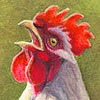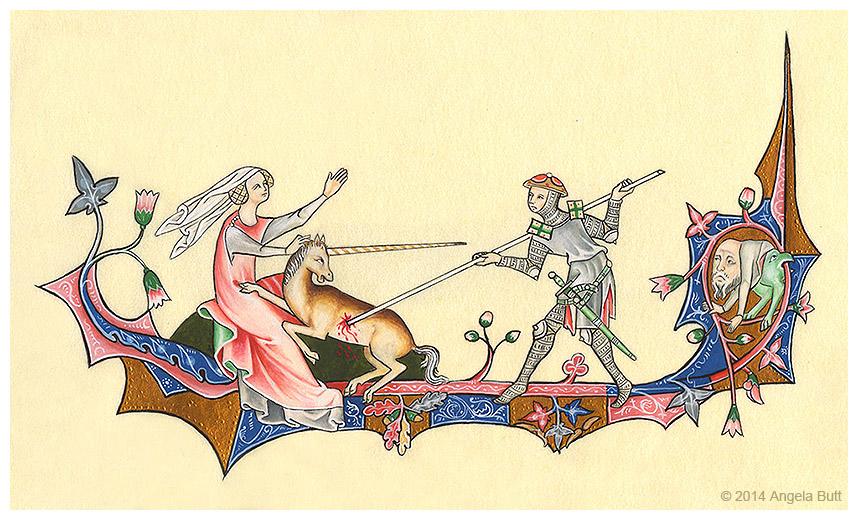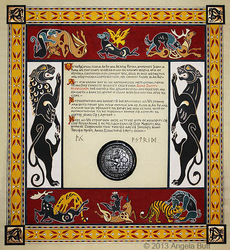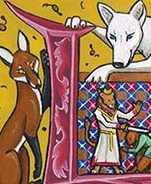Sign In
CloseWell at least that's what I hear in my head whenever I look at this.
A study piece based on a part of the Ormesby Psalter, this was done in gouache, ink and pseudo gold leaf on pergamenata.
Yay medieval mythology and imagery! Wooo!
Submission Information
- Views:
- 616
- Comments:
- 16
- Favorites:
- 17
- Rating:
- General
- Category:
- Visual / Traditional
Comments
-
-

Absolutely beautiful! I'm envious of your shading with the gouache, I'm still in the learning stages to getting them looking nice. And the Ormesby Psalter is insanely detailed in their borders and margins! I've done two illuminated scrolls based from its pages so far, it was enough to make me want to tear my hair out XD
-

Thanks!
I'm still learning myself. Because I work on perg, it's a little more difficult to do, but I just love the glow the gouache gets so it makes it worth it.
I like the Ormesby, a lot. After determining the actual size of the illuminations, I want to know how good their eyes were when they were done. Crazy, crazy dudes (or kids!)-

I've found that Holbein's Pearl Gold is a nice substitute for gold leaf, and if you also place a piece of smoothed tissue paper (the kind you stuff gift bags with), or if you can get one of those wax-envelopes that they used to store stamps in from the post office, place it over the dried gold gouache and rub it (burnish it) with a hard, smooth surface of some kind, it helps ti take away any brush marks, and it actually helps to give it a bit of a shine as well :) It's what I used and what I used to do before I went on to using gold leaf.
I've got a hard-cover facsimilie of the Macclesfield Psalter, and the way it's printed, it's at the exact same size as the actual book, which is just shy of being 4.5 x 7.5". The illuminations are insanely detailed...how they ever managed to get such small details in there, it just blows my mind! I know that after working on illuminated scrolls that are 11x14" all day long, my eyes start crying on their own (even if I happen to use my magnifying lamp), my hand, wrist and forearm hurts, and the whole left side of my neck and shoulder feels like as if someone stabbed a hot knife out of the fire into me and was wiggling it around. I can't imagine the monks doing this, and much of it was by candle light too =P It makes me appreciative of what the monks did and what they could do, and they have my respect :)
I find that a lot of ancient manuscripts go over-looked, but to me, they're works of art all on their own.
-

Yup, totally aware of the burnishing techniques. Fun stuff! When I say "glow of the gouache" I'm referring to how the regular pigments behave as a whole, not the fake gold. Have you worked with pergamenata?
I think I know what facsimile you are talking about, if it's the same one I have access to. Yeah, it's pretty damn badass.:) Having been given the pleasure to handle some historical manuscripts in my research (nothing of note, but definitely educational) I am always amazed at what they did. Definitely works of art. They also had an economy of line and technique that can only be envied.
-

I haven't tried pergamenata yet, a friend in my SCA group went to a shopping event (Market Day at Birka) and picked me up some vegetable parchment, I'm treating it as my "gateway to getting into real parchment/vellum" XD Up till now, I've just been using 140lb hotpress watercolour paper. Eventually, if I can afford it, I'd love to get vellum.
Here's a small gallery of the Macclesfield: http://www.fitzmuseum.cam.ac.uk/gallery/macclesfield/gallery/ I know it's also available as a CD-ROM, I think it can also be purchased from that same site. I was lucky to have gotten some Amazon gift cards one Christmas and I got the hard-cover edition, just awesome :)
-laughs- One of my dreams these last few years, getting into manuscripts and illuminations, is that if we ever can afford to go to England, I told my husband to drop me off at the British Library and pick me up in 2 weeks XD I've only seen manuscripts and ancient books in the art gallery back in my hometown, but they only had one or two of them out on display. That's pretty much as close as I've ever gotten to a real one.
There's still a lot I need to learn about illuminations, and I'm slowly chugging by. So far, I make award scrolls for the SCA, and occasionally I'll make something fun on the side (I love making bestiary pages, or making bestiary ATC illuminations). My calligraphy absolutey sucks, and I hope to improve on it someday...and by "improve", I mean "I really SHOULD practice it one of these days!" XD
-

Pergamenata is fun. You'll either love it or hate it. I love it even though it can be a pain to work with. I can only best describe it as being "alive" with some of it's behaviour to conditions and treatments. I buy mother sheets to cut down to whatever size I'm required to do. It's cheaper to buy this way.
Yup, I'm familiar with that Psalter. One of my associates has a copy and they often do works based on it. It is very snazzy. :) I'm more of an early period fan myself but I'm segwaying (aka being coaxed) into later periods.
I'd love to hit some of the museums overseas myself. Ah... someday. If you have any local universities/museums near by, and/or connections you can sometimes find collections where you can get restricted access too them. The trick is finding them and getting that access. I've been lucky with my connections knowing where and how to get to them. Do you have anyone local to you within the SCA doing that level of research you can tap into?
There is so much to learn; it's awesome! Oh gawds, practice, yeah. I hear that. Always practicing....oy. The hardest thing I find it avoiding muscle fatigue when working with certain scripts. At least doing the side projects where you can break loose is always fun. :)
-

I love the earlier period stuff too, the Book of Kells just blows my mind, because there's absolutely no way I could figure out how to do even the simplest celtic knotwork XD I do tend to like the later periods, usually 1100 to late 1300s are my favourite, but the even later stuff (especially Flemish and Danish) are very beautiful stuff :) I was absolutely ecstactic when the British Library released the Luttrell Psalter fully digitized online, it's one of my absolute favourites :)
We've got a friend in our SCA group, one of the founding members of our shire, actually, she works at the University of Vermont library, and she usually keeps us informed if they happen to get some special stuff there ;) Usually though, they've got a few facsimilies there, along with books with information about medieval manuscripts in general. I've only been there few times, since it's a little far for us, and parking can be tricky XD
Two things seem to happen whenever I work on my illuminations: my eye starts twitching, or my hand (or fingers) start to twitch or shake a little bit...just enough to make my lines kinda shakey at times XD It's probably nerves, since I'm trying to work with small details and stuff, it's basically no use to take a break and get back to it rested, since it'll just keep doing that anyways XD
-

Kells is a fun style! The knotwork is intriguing, as are the colours! I to do enjoy the 1100-1300 range. Lots of efficiency of line and confidence. Some of the Book of Hours also rock my socks off. Rockstar artists, they certainly were. I'm loving how more and more of the material is becoming readily available online. Makes life easier, provided they're good scans!
I take frequent stretching breaks when working, especially on small details. It's easier on my back, my eyes and certainly my hands. And because I work on perg, this actually works in my benefit as you have to let the gouache dry between layers else it might misbehave.
-
-
-
-
-
-
-
-

Nooooo now I want to try some manuscript stuff, this looks so nifty!
(Including bird-bottomed guy in the corner)
-

Yesssss. You should try it! It's an art form unto itself if you really want to get into it. The history connected to it is also /very/ cool.
That little demon guy? In period, things like him were added to protect the illuminated works (very ofter bibles, psalters etc) from demons. His job is to scare the bad guys away. You'll find them a lot once you start looking.-

Yesss I love them so much. I have a few reference things scattered through my books but nothing too in-depth (my grandad used to do calligraphy and would sometimes decorate his nifty things)
And yeah, the little demon guys are some of my favourites! Along with the stuff that makes -no- sense whatsoever because the monks were potentially very, very bored.
-
-






Link
Qzurr
Awwwwww medieval art! Amazing work hun hehe